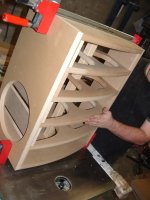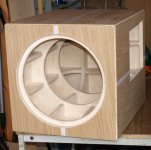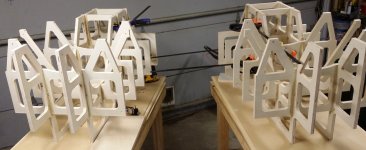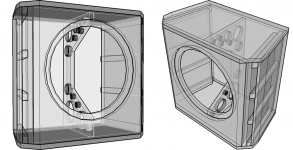Hi there I am about to build my first speaker. The Selah Audio Tempesta's.
They are a 3 way design with Raal 70-10d mids, Accuton C50 mids, and Scanspeak Illuminator 18wu/4747T00 Lows.
The Default Cabinet, Used In the Prebuilt Version is the Dayton Audio MTMC-1.0.
I have very little experience in wood working and cabinet making, but I do have some basic Autodesk Inventor Experience so I decided to Design my own Cabinet, using the front baffle dimensions provided by Rick Craig at Selah Audio. I have also tried to take some designs cues from the Dayton Cabinets.
I will be Constructing them out of MDF. Front Baffle Dimensions are:
9" (228.6mm) x 22" (558.8mm) x ~1"(25mm) (WxHxD)
I originally planned to make the the all the other sides of the cabinet out of 18mm thick MDF, but have since decided to go with 25mm, unless 18mm is fine.
I'm Based In Australia so alot of the things needed for construction I have to source locally, so no parts express.
The Dampening Materials I have choose are these:
Shop Online | Foamland
and this for the speaker stuffing stuff : 650gsm Acrylic Speaker Dampening Material | Jaycar Electronics
If anyone has any objections to these, that I can source locally here in Australia, please fire away.
I also do have some questions on the Cabinet design.
firstly is 25mm thick MDF enough, I don't really want to go anymore than that as it would effect the total internal volume.
Secondly, I'm planning on getting the cabinet CNC cut, should I remove the screw holes in my CAD file and do them by manually once everything else is cut to scale.
I have uploaded images of my CAD design below, advice on whether or not it is a sound design would be appreciated, especially when it comes to advice on the cabinet bracing, something I have no idea about.
The Last 3 Images are, the Braces, with the 3rd last one being the front brace, 2nd last one the middle brace, where the Crossover's mount and the last brace is one that I did, that I can add later one, though I'm not sure if it is necessary.
I'm also planning on using finger joints for the cabinet sides, and dowel joints for the braces. Again any recommendations are appreciated.
Speaker Dimensions are:
228.6mm (9in) x 558.8mm (22in) x 368mm
Any Help/Advice would be appreciated for a first timer.
They are a 3 way design with Raal 70-10d mids, Accuton C50 mids, and Scanspeak Illuminator 18wu/4747T00 Lows.
The Default Cabinet, Used In the Prebuilt Version is the Dayton Audio MTMC-1.0.
I have very little experience in wood working and cabinet making, but I do have some basic Autodesk Inventor Experience so I decided to Design my own Cabinet, using the front baffle dimensions provided by Rick Craig at Selah Audio. I have also tried to take some designs cues from the Dayton Cabinets.
I will be Constructing them out of MDF. Front Baffle Dimensions are:
9" (228.6mm) x 22" (558.8mm) x ~1"(25mm) (WxHxD)
I originally planned to make the the all the other sides of the cabinet out of 18mm thick MDF, but have since decided to go with 25mm, unless 18mm is fine.
I'm Based In Australia so alot of the things needed for construction I have to source locally, so no parts express.
The Dampening Materials I have choose are these:
Shop Online | Foamland
and this for the speaker stuffing stuff : 650gsm Acrylic Speaker Dampening Material | Jaycar Electronics
If anyone has any objections to these, that I can source locally here in Australia, please fire away.
I also do have some questions on the Cabinet design.
firstly is 25mm thick MDF enough, I don't really want to go anymore than that as it would effect the total internal volume.
Secondly, I'm planning on getting the cabinet CNC cut, should I remove the screw holes in my CAD file and do them by manually once everything else is cut to scale.
I have uploaded images of my CAD design below, advice on whether or not it is a sound design would be appreciated, especially when it comes to advice on the cabinet bracing, something I have no idea about.
The Last 3 Images are, the Braces, with the 3rd last one being the front brace, 2nd last one the middle brace, where the Crossover's mount and the last brace is one that I did, that I can add later one, though I'm not sure if it is necessary.
I'm also planning on using finger joints for the cabinet sides, and dowel joints for the braces. Again any recommendations are appreciated.
Speaker Dimensions are:
228.6mm (9in) x 558.8mm (22in) x 368mm
Any Help/Advice would be appreciated for a first timer.
Attachments
-
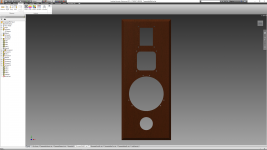 FrontBaffle1.png537.2 KB · Views: 614
FrontBaffle1.png537.2 KB · Views: 614 -
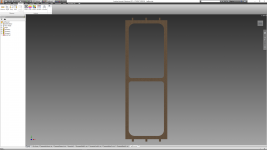 Screenshot (54).png333.7 KB · Views: 84
Screenshot (54).png333.7 KB · Views: 84 -
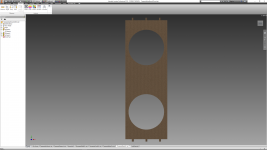 Screenshot (53).png609.8 KB · Views: 67
Screenshot (53).png609.8 KB · Views: 67 -
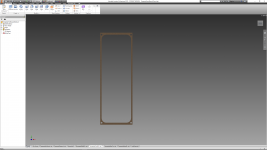 Screenshot (52).png188.1 KB · Views: 93
Screenshot (52).png188.1 KB · Views: 93 -
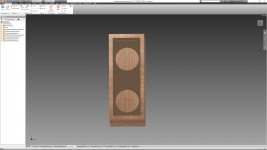 Screenshot (56).png641.4 KB · Views: 574
Screenshot (56).png641.4 KB · Views: 574 -
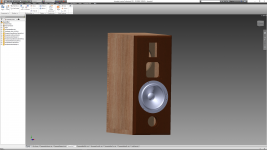 Screenshot (55).png851.1 KB · Views: 585
Screenshot (55).png851.1 KB · Views: 585 -
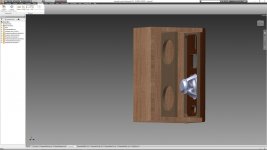 Screenshot (49).jpg195.6 KB · Views: 581
Screenshot (49).jpg195.6 KB · Views: 581 -
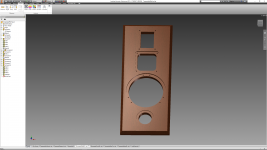 FrontBaffle2.png562.3 KB · Views: 607
FrontBaffle2.png562.3 KB · Views: 607
Last edited:
Your plan is fine. All my suggestions are marginal improvements.
--I will be Constructing them out of MDF.
If you're spending >$2000 importing all the drivers, spending a bit more on good ply makes sense.
--The Dampening Materials I have choose are these:
Damping, not dampening
IMO, rubber floormats from a hardware shop are another good option. Similar anti-vibration properties + a much more complex surface.
--speaker stuffing stuff : 650gsm Acrylic Speaker Dampening Material | Jaycar Electronics
An old pillow = just as good. Wool = better: get some ugly wool garments from an op shop, and hack them up.
--I have uploaded images of my CAD design below, advice on whether or not it is a sound design would be appreciated, especially when it comes to advice on the cabinet bracing, something I have no idea about.
The biggest panels are the best to brace, so a couple of (horizontal) shelf braces would be better than one vertical brace.
--I'm also planning on using finger joints for the cabinet sides, and dowel joints for the braces. Again any recommendations are appreciated.
Dado joins would be just as good, and they'd be faster to plan and cut than finger joints. Particularly with MDF, finger joints are overkill. A well-glued butt join is stronger than the 'wood'.
Other / general tips:
Expect to pay 2* the US prices for drivers once you've paid shipping and taxes.
Chamfer the woofer cutout.
Chamfer the front baffle edges.
Flush mount all the drivers. I dunno why the Tempesta has the midrange flush but the RAAL slightly protruding.
Where are you? Have you got a CNC place lined up? I'm in Melbourne, and could possibly refer you to a hobbyist CNC guy.
--I will be Constructing them out of MDF.
If you're spending >$2000 importing all the drivers, spending a bit more on good ply makes sense.
--The Dampening Materials I have choose are these:
Damping, not dampening
IMO, rubber floormats from a hardware shop are another good option. Similar anti-vibration properties + a much more complex surface.
--speaker stuffing stuff : 650gsm Acrylic Speaker Dampening Material | Jaycar Electronics
An old pillow = just as good. Wool = better: get some ugly wool garments from an op shop, and hack them up.
--I have uploaded images of my CAD design below, advice on whether or not it is a sound design would be appreciated, especially when it comes to advice on the cabinet bracing, something I have no idea about.
The biggest panels are the best to brace, so a couple of (horizontal) shelf braces would be better than one vertical brace.
--I'm also planning on using finger joints for the cabinet sides, and dowel joints for the braces. Again any recommendations are appreciated.
Dado joins would be just as good, and they'd be faster to plan and cut than finger joints. Particularly with MDF, finger joints are overkill. A well-glued butt join is stronger than the 'wood'.
Other / general tips:
Expect to pay 2* the US prices for drivers once you've paid shipping and taxes.
Chamfer the woofer cutout.
Chamfer the front baffle edges.
Flush mount all the drivers. I dunno why the Tempesta has the midrange flush but the RAAL slightly protruding.
Where are you? Have you got a CNC place lined up? I'm in Melbourne, and could possibly refer you to a hobbyist CNC guy.
I like your tips, hollowboy! Couldn't have done better myself.
I like using dowels for bracing, myself.
For damping, in case of wall lining, I absolutely love using the covering material from old mattresses. The cotton side to the wood, and the wooly side to the inside of the cabinet. I've found this to work better at times than the 'nibs foam'.
I like using dowels for bracing, myself.
For damping, in case of wall lining, I absolutely love using the covering material from old mattresses. The cotton side to the wood, and the wooly side to the inside of the cabinet. I've found this to work better at times than the 'nibs foam'.
I thankfully have all the Speaker Drivers, I didn't pay that much more than I would in the US (In some cases even cheaper) .
Thanks for the suggestion on the dado joints, your right, finger joints would be a pain to assemble and do up.
For the Bracing someone suggested to me, that instead of using dowels, I just use screws with a lot of glue.
Also how much bracing should I use?. I will keep the front and middle brace that I have on already, but will add more, I'm just not sure how many more braces I should add and how should I place them. Is 1 additional Horizontal brace Ok?.
I have read that birch ply is better for speaker building, but I don't exactly know where to source it at an affordable price in Australia.
Are any Australian Hardwoods Suitable for Speaker Building?.
For the Damping, I already have the 10mm closed cell foam. Shop Online | Foamland
As well as the Acrylic Speaker Stuffing from Jaycar, I don't really want to go out and spend more on the damping material, unless the results would be a noticeably better sound quality.
Thanks for the suggestion on the dado joints, your right, finger joints would be a pain to assemble and do up.
For the Bracing someone suggested to me, that instead of using dowels, I just use screws with a lot of glue.
Also how much bracing should I use?. I will keep the front and middle brace that I have on already, but will add more, I'm just not sure how many more braces I should add and how should I place them. Is 1 additional Horizontal brace Ok?.
I have read that birch ply is better for speaker building, but I don't exactly know where to source it at an affordable price in Australia.
Are any Australian Hardwoods Suitable for Speaker Building?.
For the Damping, I already have the 10mm closed cell foam. Shop Online | Foamland
As well as the Acrylic Speaker Stuffing from Jaycar, I don't really want to go out and spend more on the damping material, unless the results would be a noticeably better sound quality.
I thankfully have all the Speaker Drivers, I didn't pay that much more than I would in the US (In some cases even cheaper) .
Good score. How did you manage that?
Also how much bracing should I use?. I will keep the front and middle brace that I have on already, but will add more, I'm just not sure how many more braces I should add and how should I place them. Is 1 additional Horizontal brace Ok?.
Anything is OK. Your base design was good. I made a mistake: I was mainly looking at the 3rd picture, and didn't realise you already had a horizontal brace in your plan.
I have read that birch ply is better for speaker building, but I don't exactly know where to source it at an affordable price in Australia.
You're probably reading a lot of US and Europe based comments. Birch is available here, but not common.
Any ply that doesn't look flaky or bad should be better than MDF. Ask at the timber yard, or just look at the cut edge, and see how good it looks, e.g. this:
Austral Marine Plywood
I'm currently working with formply - the black plywood that's used on building sites for concrete pours because it:
a) is robust, suitable for outdoor use
b) has the same F17 grade as the linked marine ply, but at a lower cost.
b) can be bought in 1200*1800 sheets, which I can fit in my van
Are any Australian Hardwoods Suitable for Speaker Building?.
Yes. Many species from Australia are grown internationally for their timber. However, most structural timber sold in Australia doesn't state the species. The linked 'marine ply' is an anomaly, in that it states 'plantation Hoop Pine'.
As well as the Acrylic Speaker Stuffing from Jaycar, I don't really want to go out and spend more on the damping material, unless the results would be a noticeably better sound quality.
Fibreglass and wool are among the better types of stuffing - but anything is OK. Your base design was good.
Ok thanks for your advice so far, I'll find some good quality Marine Ply. Just wondering is ply harder to work with, I had a wood working class at school years ago and I remember the ply cracking/chipping off sometimes. Also how thick should the ply be, my local Bunnings store only seems to sell upto 18mm thick, though I'm sure I can find someone selling 25mm thick.
I'm based in Tas, so there aren't as many options as the mainland.
What do you think of the bracing in this, Screenshot (57).png - Google Drive.
Would it be better to push the last brace with the horizontal part, further back until it is attached to the rear cabinet wall, or is the bracing I already have adequate.
I have found a supplier of Birch Ply, here in Hobart, that sells upto 24mm thick. They also sell 25mm Marine Ply as well.
Birch Ply (Russian) | Bunker Plywood Hobart Tasmania
Marine | Bunker Plywood Hobart Tasmania
I purchased the Raals off ebay for about 50 cheaper than Madisound shipped, the accutons I got used for a bit under 400 for the pair, and the Scanspeaks I purchased from just over 720aud shipped, A fair bit cheaper than Madisound sells them at 292usd (373aud) each.
I'm based in Tas, so there aren't as many options as the mainland.
What do you think of the bracing in this, Screenshot (57).png - Google Drive.
Would it be better to push the last brace with the horizontal part, further back until it is attached to the rear cabinet wall, or is the bracing I already have adequate.
I have found a supplier of Birch Ply, here in Hobart, that sells upto 24mm thick. They also sell 25mm Marine Ply as well.
Birch Ply (Russian) | Bunker Plywood Hobart Tasmania
Marine | Bunker Plywood Hobart Tasmania
I purchased the Raals off ebay for about 50 cheaper than Madisound shipped, the accutons I got used for a bit under 400 for the pair, and the Scanspeaks I purchased from just over 720aud shipped, A fair bit cheaper than Madisound sells them at 292usd (373aud) each.
There is no use of closed cell foam for damping. To suppress air standing waves inside enclosure, use poly wadding that you might find at upholstery supplies, 25 mm or so thick then rolled up to fit the space. Some room should be left for woofer and vent breathing. 25 mm of panel thickness for the enclosure is unnecessary, maybe just for the front baffle, others can be 15 or 18, or less if you brace it well. Naturally ply is harder on tools but some are concerned with cancerous mdf parts so it's safer with ply. Breathing protection mask should be used at all times.
Volume filling a reflex box
Volume filling a reflex box
Last edited:
Ok thanks for that, should I just stick with this to line and damp the speaker cabinet. 650gsm Acrylic Speaker Dampening Material | Jaycar Electronics
I have already purchased this so I don't really want to go out and get something else unless it is superior enough
For the cabinet I'll go with 18mm sides thens. From either 18mm or 24mm, brich or marine ply.
I have already purchased this so I don't really want to go out and get something else unless it is superior enough
For the cabinet I'll go with 18mm sides thens. From either 18mm or 24mm, brich or marine ply.
The Birch Ply is around 3x more expensive than the MDF, I do wants these speakers to last a long time and to do these Drivers justice, So I will still consider Birch Ply.
So should I just ditch the 10mm closed cell foam, someone told me it will still help with reverse waves.
So should I just ditch the 10mm closed cell foam, someone told me it will still help with reverse waves.
The Birch Ply is around 3x more expensive than the MDF, I do wants these speakers to last a long time and to do these Drivers justice, So I will still consider Birch Ply.
Do you need the ply to be pretty? If you are painting / veneering your speaker, you can use a cheap and bland variety.
I'm using something similar to this - a hardwood ply that only costs a few dollars more than MDF.
Specrite Formply F17 1800 x 1200 17mm Plywood | Bunnings Warehouse
Note that it is stamped F17, which is the same stress grade (strength) as the marine ply I linked earlier ...but it costs about 1/3 of the price.
Unlike birch, this is locally grown, which probably helps keep the price down.
So should I just ditch the 10mm closed cell foam, someone told me it will still help with reverse waves.
Probably. You could always try one with and one without, to see for yourself.
I've attached a few pix of bracing schemes. One of the benefits of CNS is being able to easily make a fairly complex matrix. Note how these all have a lot of bracing that abuts the woofer panel.
Attachments
The Birch Ply is around 3x more expensive than the MDF, I do wants these speakers to last a long time and to do these Drivers justice, So I will still consider Birch Ply.
The plywood is well worth it.
dave
I heard people say that MDF is heavier and more sense than PLY.
Indeed it is, but because it is not stiffer that is a bad thing. Denser is only tolerable if it brings much greater stiffness.
You’ll also hear that MDF is better damped… but everytime the sound attempts to cross the glue boundary from one ply to the next (which is oriented the other way) you get a loss of energy — ie damping.
AFAIC MDF should only be used to build speaker boxes if that is all you can get.
dave
The MDF will just drag down the plywood. Spending time & wood on bracing* will make a greater difference. Try to push resonances up to where they will never get excited.
*(don’t put a brace on the middle of a panel and orient the braces such that the subpanel that the brace creates has a greater aspect ratio than the panel you are bracing. And it doesn’t hurt to brace at least the bass drivers such that their reactive energy is spread across multiple panels).
The 3d visualization shows a simple holey brace that couples the driver to the back, bottom & top panels (the side construction is naturally braced).
dave
*(don’t put a brace on the middle of a panel and orient the braces such that the subpanel that the brace creates has a greater aspect ratio than the panel you are bracing. And it doesn’t hurt to brace at least the bass drivers such that their reactive energy is spread across multiple panels).
The 3d visualization shows a simple holey brace that couples the driver to the back, bottom & top panels (the side construction is naturally braced).
dave
Attachments
Here is what I have so far. Screenshot (57).png - Google Drive
Do you recommend removing the middle brace shown then.
The pre-built Selah audio Tempesta use a Dayton MTMC-1.0 with a similar looking middle brace part. That middle brace part is also where the crossovers are supposed to mount.
Thanks for the help so far, sorry if any of my questions seem silly.
Do you recommend removing the middle brace shown then.
The pre-built Selah audio Tempesta use a Dayton MTMC-1.0 with a similar looking middle brace part. That middle brace part is also where the crossovers are supposed to mount.
Thanks for the help so far, sorry if any of my questions seem silly.
Here is what I have so far.
The parallel projection makes it hard to visualize the aspect ratio. If the box is as deep as it looks then the side to side brace is needed but a brace front to back to brace the drivers would be a good idea. And you may have the box too narrow… something we have found that causes a cupped sound in the mids from early reflections.
… Dayton MTMC-1.0 with a similar looking middle brace part...
The curve Dayton cabinets are decidely better than the rectangular ones. As to the brace the curved MDF plywood sides are likely not what needs bracing the most, but with the blank baffles these come with the manufacturer has no idea what or where the baffle is going to be cut so doing a brace to stiffen the baffle (the weakest panel) is not doable. We did do a vestigial brace on the baffle of the pair we used. The MDF on these is also kinda low density and not all that stiff — the sides made of MDF plywood are the saving grace. The low density MDF is really easy to ding, and then the really pretty finish goes away. We decided it is just easier to start from scratch than to use these.
Ideally the XO should not be in the box… tidier, but both caps & indcutors can be affected by vibration.
dave
- Status
- This old topic is closed. If you want to reopen this topic, contact a moderator using the "Report Post" button.
- Home
- Loudspeakers
- Multi-Way
- First Time Speaker Build, Cabinet Advice
